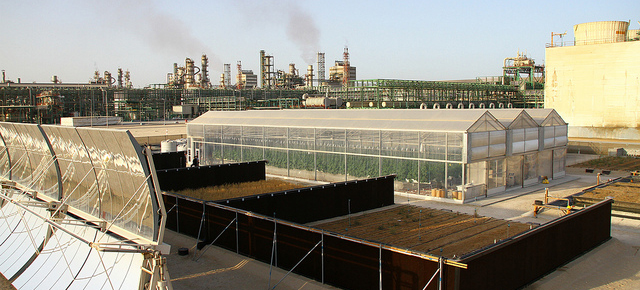As conventional sources of clean water dry up, we’re looking ever farther, wider, and deeper. In a long feature on unusual sources of water, Nature leads us somewhere especially unexpected — into the middle of a desert. The Sahara Forest Project wants to prove we can green the desert, turning barren land into oases of cucumbers and melons. And the water? It will come from the sea.
The unusual idea is made possible by greenhouses, but not greenhouses as you know them. Instead of trapping heat, the Sahara Forest Project’s greenhouses are cool and moist. Here’s how Science described the pilot facility in the Qatar last year:
At one end, salt water is trickled over a gridlike curtain so that the prevailing wind blows the resulting cool, moist air over the plants inside. This cooling effect allowed the Qatar facility to grow three crops per year, even in the scorching summer. At the other end of the greenhouse is a network of pipes with cold seawater running through them. Some of the moisture in the air condenses on the pipes and is collected, providing a source of fresh water.
Surprisingly, moist air leaking out from the greenhouse encouraged plants around the buildings too. While cucumbers and tomatoes grew inside the greenhouse, arugula and barley could grow right outside.
The facility also takes advantage of one natural resource in abundance in the desert: sun. Solar panels generate electricity for the pump systems, and excess electricity can go toward desalination of additional seawater.
Last year, the Sahara Forest Project harvested the first crops from its pilot location in the Qatari desert. Their yield was comparable to a traditional greenhouse of the same size, and now they’re aiming to build a larger test facility in Jordan. As all new tech goes, this is currently an incredibly expensive way to grow some salad. That could change though, especially in an increasingly thirsty world.
The piece over at Nature has several other slightly crazy but somehow plausible water ideas, like harvesting fog and reviving 2000-year-old waterworks. Just another reminder that getting clean water is a lot more complicated than turning on your faucet. [Nature, Science]
